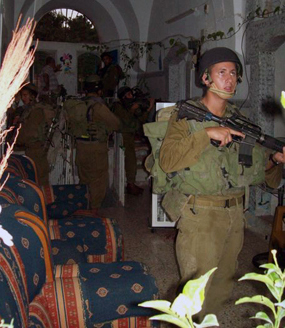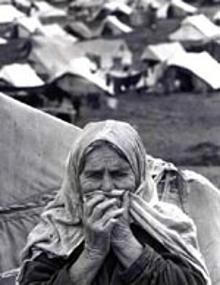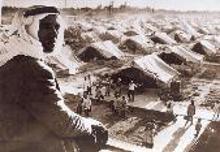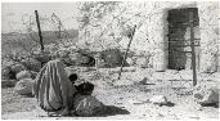Kawther Salam continues to stand up for her people and their rights before God.
_________________________________________________________________________________
_________________________________________________________________________________
_______________________________________________________________________________
We must obey God and never the minions of the Anitichrist, no matter what pretended authority they claim to have.
The Law of God is for all men and is written upon our hearts and is in our consciences and is our guide to doing good.
organizations and spies including neighborhood spies. MI6 pioneered the use of
) to disrupt and destroy peoples and nations they wanted to take over. The NKVD (Cheka, GPU, KGB, FSB) and OSS-CIA and Mossad are modeled on that. None of them are loyal to anyone or anything but are Satanic subversives working for the aims and goals of the
). There is NOTHING lawful NOR justified in any of them at all - not ever. They are responsible on the way to the short lived world wide Devil worshiping empire of the
for all the genocides in South America and Central America and Mexico and Europe and Russia and China and Africa and the Middle East, especially Occupied
. Especially they use
to advance their Satanic agenda. Anyone who sides with them or helps them or submits to them is damned for eternity with them.
[14] Then went one of the twelve, who was called Judas Iscariot, to the chief priests, [15] And said to them: What will you give me, and I will deliver him [Jesus Christ] unto you? But they appointed him thirty pieces of silver. [16] And from thenceforth he sought opportunity to betray him.
[71] Jesus answered them: Have not I chosen you twelve; and one of you is a devil? [72] Now he meant Judas Iscariot, the son of Simon: for this same was about to betray him, whereas he was one of the twelve.
And when supper was done, (the devil having now put into the heart of Judas Iscariot, the son of Simon, to betray him,)
The end of all spies and saboteurs and betrayers and Gulag state tryannical oppressors is
.
These both apply to all of them.
You are of your father the devil, and the desires of your father you will do. He was a murderer from the beginning, and he stood not in the truth; because truth is not in him. When he speaketh a lie, he speaketh of his own: for he is a liar, and the father thereof.
Then he shall say to them also that shall be on his left hand: Depart from me, you cursed, into everlasting fire which was prepared for the devil and his angels.
_______________________________________________________________________________
_____________________________________________
Documents Reveal Pentagon's Scrutiny of Zapatistas and Mexican Military | Mexico |Axisoflogic.com
Documents Reveal Pentagon's Scrutiny of Zapatistas and Mexican Military
By Kate Doyle
Wednesday, Jan 28, 2004
Americas Program, Interhemispheric Resource Center (IRC) www.americaspolicy.org
This article continues the Archivos Abiertos series of monthly reports on U.S.-Mexico relations produced by the Americas Program in collaboration with the National Security Archive in Washington, DC and its Mexico Project. As Mexico Project director Kate Doyle explains: "The main objective of the project is to challenge the myths of foreign policy--on both sides of the border." To that end, Doyle combs nearly four decades of U.S. and Mexican archives to uncover new evidence and bring to light the hidden histories behind the bilateral relationship. The results, presented in this monthly series, offer the unprecedented opportunity to separate the rhetoric from the reality, and provide a foundation for rebuilding binational diplomacy on the basis of shared interests, transparency, and citizen involvement. The original documentation, as well as previous articles, may be found at www.nsarchive.org/mexico. Your comments are welcome at .
When the United States government considered the rebellion in Chiapas, it did so through the twin lenses of its primary national interests: money and power.
The Zapatista uprising exploded on January 1, 1994, the eve of the inauguration of the North American Free Trade Agreement (NAFTA). The uprising challenged an image of Mexico that had been peddled for months in the halls of the U.S. Congress in an effort to gain approval for the historic trade pact. According to the NAFTA lobby, Mexico was a modern, youthful nation, eager for change--unencumbered by the chains of its own political history or by the centuries of rural poverty and oppression.
The events of 1994 were a shock to the inflated expectations of American investors. However, U.S. military and intelligence planners weren't taken by surprise. Pentagon documents reveal that they had been following the emergence of the Zapatistas at least since early 1992. They regarded the Mexican government's response to the uprising as a window into an institution known for its supreme secrecy, silence, and resistance to public scrutiny: the Mexican armed forces.
The Mexican Army was an institution that was (and remains) resolutely closed to American engagement. The history of post-World War II security relations between the United States and Mexico is a tale of frustration on the part of U.S. military officials at their inability to penetrate the Mexican army as they had other allied militaries in the western hemisphere. Unlike many of its Central and South American neighbors, Mexico's Defense Secretariat ( Secretar�a de la Defensa-- SEDENA) consistently rejected the swollen grant aid packages of weapons and equipment that the United States offered throughout the cold war, thereby enabling it to preserve its sense of independence and distance from the colossus to the north.
Reading through hundreds of declassified cables, reports, and intelligence analyses produced by the Defense Intelligence Agency (DIA) during the first twelve months of the rebellion, one learns very little about the social, political, or economic factors that lay behind the Zapatista uprising. But the documents are replete with new and interesting details about the Mexican military.
As Mexico marks the tenth anniversary of the rebellion, the country finds itself poised to challenge for the first time in modern memory the army's refusal to open itself to civilian scrutiny and influence.
Know Thy Enemy
Washington 's professed surprise at the Zapatista uprising is belied by two years of reports by Pentagon officials on suspicious and clearly subversive activities in Chiapas .
Although the Mexican government publicly portrayed early encounters with rebels in 1992 and 1993 as counternarcotics operations or contacts with Guatemalan guerrillas who had crossed the border to foment unrest, declassified DIA documents paint another picture.
In April 1992, for example, U.S. defense attach�s reported on a secret directive circulated by the Defense Secretariat's Intelligence Section placing military units on alert due to what it called �a national series of crimes.� The directive dubbed common criminals and narcotraffickers as the perpetrators, but noted that �some of them may have been executed by clandestine organizations or militants to fulfill their ideological ends.� Among the evidence of subversive activities mentioned in the document were �training camps discovered in the state of Chiapas ��
The first reference to the Zapatista army in U.S. defense documents occurred shortly after the clash between military and rebel forces in late May 1993, when SEDENA sent more than 3,000 soldiers into Chiapas on what it characterized as a civic action mission. The embassy's Defense Attach� Office (DAO) described massive maneuvers in the Ocosingo valley using �light armored vehicles, helicopter bombing support, and infiltration of parachute troops into hard to access areas.�
In its discussion of the unusual request of Chiapas ' Senator Antonio Melgar to the government for an increased military presence in his state to curb �Guatemalan guerrilla activities,� the DIA named a Mexican rebel group as the real guerrillas. The DIA cable (June 14, 1993) �tentatively identified [it] as the Zapatista National Liberation Front (FZLN).�
The DAO wrote, �The Defense Secretariat maintains a curious, yet predictable, silence on military operations conducted over the past two weeks against possible guerrillas in Chiapas . To date, the military has only publicly admitted to light casualties and the completion of civic action projects in the region.� When a public bulletin was issued by SEDENA claiming to have conducted civic action and counternarcotics activities in the area, the DIA quoted an Excelsior newspaper article that referred to the �huge hermetic secrecy� maintained by senior military officials about what was happening in Chiapas.
A secret intelligence assessment from the State Department's Bureau of Intelligence and Research (INR) written on January 3 helped explain the regime's refusal to acknowledge a rebel presence before January 1. For some time before the uprising, wrote an INR analyst, the activities of radical indigenous groups in Chiapas had triggered anxiety �at the highest level of the Mexican government.� The government maintained a strict silence on the matter, however: �Concern over the impact of political unrest on NAFTA led Salinas to downplay reports last spring of an incipient insurgency in the conflict-ridden state of Chiapas following the murders of several soldiers.�
On January 10, the Pentagon referred to the Mexican military's anger at official silence about the Zapatistas, observing that �Though the armed forces have been aware of the guerrillas' existence in Chiapas , they feel that they have been prevented from eradicating them. Eradication efforts would have entailed military operations that may have proven politically suicidal for the government.�
Military Incompetence
After several confused early assessments of the uprising, the DIA issued a secret intelligence forecast on January 5, containing a relatively accurate portrayal of what was happening:
(C/NF) Further insurrectionist violence is likely to occur in southern Mexico in the coming months.
-- The 1 January incident demonstrated highly professional planning, leadership, and operational competence of the rebel Zapata Army of National Liberation (EZLN) that took control of four towns in Chiapas .
-- The rebels are probably operating from sanctuaries along the Guatemala-Mexico border. Their sources of funding and equipment are not known.
-- The pervasive poverty in the region will probably provide the rebel cadre ample opportunity for inciting the local peasantry to further acts of violence.
(C/NF) While the insurgents are not strong enough to face the Mexican army, neither is the army capable of eradicating the rebels in hiding. The government will seek to restrain the army to avoid local complaints of army human rights abuse. A stand-off with recurring violence could frighten foreign investors and embarrass the government, affecting presidential elections in August. The government will beef up security in the region, and could be tempted into repressive tactics.
The Mexican armed forces' incompetence and lack of preparation in facing were recurring themes in the American documents. U.S. defense experts observed that the military had no real counterinsurgency capabilities, did a poor job gathering intelligence, and failed to comprehend the crucial role of public relations in �selling� their operations to the Mexican people.
The army also misrepresented its capabilities to combat the Zapatistas, even to its allies in other military institutions. During a briefing given in January 1994 by senior Mexican army officers for foreign military attach�s, the Mexicans claimed to have been monitoring the situation in Chiapas since 1983 and said they had compiled a complete list of names of individuals suspected of ties to the insurgents. The DAO's political section commented skeptically on the information in a cable written January 27:
Judging by our information from other sources, the Mexican military's claims either to having had such extensive knowledge of the EZLN and its membership prior to the outbreak of hostilities or to having reliably obtained additional names for that list since January 1 should be heavily discounted. We know, for example, that the military asked through many channels--including non-governmental sources--for contributions of names of suspected or possible members, supporters or contacts of the EZLN, and that among the lists given them was the entire list of Dominican priests in Chiapas; the names of all Mexican priests regardless of location in the country who attended the 1968 church meeting in Medell�n, Colombia, which was the beginning of the Liberation Theology movement; and all of the foreign-born Catholic priests, friars, and nuns who have worked in Chiapas since the beginning of Bishop Samuel Ruiz' incumbency as Bishop of San Cristobal (he has been Bishop there for more than three decades). We have learned reliably that all of these names are now on the Mexican military's list of known EZLN members. [�] We have been told that the military has no way of knowing whether or not most of the people on its list are, in fact, in any way involved or connected.
Faced with the mounting realization that its troops were ill-equipped to combat the rebels, SEDENA began to introduce critical changes into doctrine, training, and operations in an effort to improve both its public image and its fighting capability in the field. On the publicity front, for example, the DAO reported on April 21 that the army recognized that the Zapatistas had trounced its own feeble efforts to win Mexicans' hearts and minds: �The military is in the process of addressing this rather severe shortcoming by sending public-relations exchange teams abroad in an effort to develop a more meaningful, positive relationship with the media.�
�Talking to the press goes against the institutional nature of the Mexican army,� wrote the DAO one week later, but �for the first time the Army is attempting to put a human face on the institution.�
Reflecting what U.S. defense planners called in August 1994 �the military's determination to remedy the deficiencies revealed by the Zapatista rebellion in January,� the Mexican army created new counterinsurgency units, conducted anti-guerrilla exercises in other areas of potential conflict around the country (such a 1,500-man training exercise in Guerrero in June), and bought expensive new equipment designed for low-intensity conflicts such as the rebellion in Chiapas.
Among the purchases were four stealth aircraft--the Schweizer �Condor� plane, a motorized glider designed to provide covert surveillance capability--and Israeli-made �Aravas,� used for intelligence collection.
In a cable sent to Washington on June 20, 1994 , the DAO offered an extensive analysis of the prospects for violence as national elections neared . The office observed some of the changes that had been made by the military institution since the uprising began:
The army has developed and is prepared to execute on order an offensive contingency plan for Chiapas, and strategic plans for mobilization throughout the national territory in the event of pre- or post-election violence.
The military is updating doctrine to better prepare, strategically and tactically, to fight a protracted guerrilla war.
The military is rebuilding elements of its force structure to better fight the same type of internal enemy.
The military is upgrading its equipment to support the counterinsurgency doctrine and re-organization.
Foreigners to the Rescue
Throughout the conflict the Mexican government claimed to have evidence of �external support� for the Zapatistas--including ties to Guatemalan rebel groups, Nicaragua 's Sandinistas, the FMLN of El Salvador, and even remnants of Argentina 's former guerrilla fighters--but was never able to prove its case convincingly.
Despite the government's insistence that the guerrillas were receiving extensive foreign aid, U.S. defense officials repeatedly discounted such contacts, pointing out that it was in the regime's interest to make the Zapatista army appear a more formidable threat than it actually was.
A DIA cable of January 27, 1994 , for example, included a Mexican report on having intercepted the radio communications of Guatemalan guerrillas fighting alongside Zapatista rebels. In a comment by the political section of the Defense Attach� Office, the embassy told Washington that the report should be disregarded.
Intelligence collected on communications between Guatemalan guerrillas operating near the border with Mexico, explained the cable, indicated that they were almost always conducted in Mam or other Indian dialects, �yet Mexican army signals intelligence units, like their civilian Mexican intelligence agency counterparts, have no personnel who speak or understand any of these languages. [�] The Mexican military is trying through a variety of means to show that the EZLN force it now combats is a bigger than life underground group of vast international connections. A good portion of the Defensa claims to substantiate that image have been patently incorrect��
What the Salinas government did not publicize was the extent of foreign support received during the protracted conflict by the Mexican Army. It began with the American weapons and military equipment provided under U.S.-Mexican drug enforcement programs, but also included critical assistance from the armed forces of Britain, Chile, Argentina, and Guatemala, among other countries.
Neighboring Guatemala was a special case. Three days after the Zapatistas burst onto the scene, Salinas called his counterpart in Guatemala directly to discuss his concerns of URNG (Guatemalan National Revolutionary Unity-Unidad Revolucionaria Nacional Guatemalteca) involvement in the rebellion. President Ramiro de Le�n Carpio offered to help with intelligence about rebel movements, and Salinas sent a team of civilians and military personnel to Guatemala that night for security briefings. This team was led, according to a January 4 U.S. defense cable, by Lt. Col. Edgar Ricardo Bustamante Figueroa, head of Presidential Security and a known expert on the URNG.
The talks were followed on January 6 by a meeting at the headquarters of Guatemalan Military Zone 22 in Playa Grande between Gen. Miguel God�nez (then chief of Mexico's VII Military Region) and a group of Guatemalan commanders, including Army Chief of Staff Jos� Luis Quilo Ayuso, the head of the notoriously brutal intelligence section of the Guatemalan army (D-2), and Guatemala's chief of operations.
These meetings and others led to extensive cooperation and communication between the two militaries, as they exchanged intelligence information about their respective insurgencies, reciprocated with visits between border military detachments, and carried out coordinated counterinsurgency operations. Beginning in early 1994, the Mexican army even sent officers to attend the infamous Kaibil jungle operations course in the Pet�n (a class so demanding, wrote one U.S. defense officer, that one group of Mexican officers �was not physically able� to complete it).
According to U.S. documents, in addition to the ongoing assistance from the Guatemalan armed forces, the Mexicans received extensive help from other foreign militaries:
--According to a DIA document dated May 11, 1994 , soldiers from the British Army provided Mexico's First Military Police Brigade with training on their base at Military Camp One in Mexico City, designed to address Mexican military shortcomings in mine warfare.
-- Israel and Spain were among other countries that sent security personnel to Mexico to provide training to army and police forces, according to the same document.
--The DIA reported on November 28, 1994 , that in preparation for the inauguration of the new PRI (Institutional Revolutionary Paty-- Partido Institucional Revolucionario) governor of Chiapas in December, the Mexican military stepped up aerial surveillance over rebel-held territory, resupplied its units, and enlisted the assistance of the Chilean military to train Mexican soldiers in counter-guerrilla operations.
--In late 1994, retired Argentine military officers were reported to be advising the Mexicans in urban guerrilla warfare, to which the DIA commented on December 5, �The Argentine military has kept a watchful eye on the developments of the Mexican uprising in Chiapas . [�] They feel that [the] failure of the Zapatistas would act as a deterrent for any potential Argentine internal political violence and would be in the best interests of Argentina .�
The Zapatista rebellion did not completely change the way the Mexican armed forces operated. However, as one lengthy State Department report observed in May 1995 on what it called �the Chiapas effect,� the military had decided in the course of the uprising that it needed to create more solid combat capabilities.
�In many ways, the Mexican Army in modern times has functioned more as a highly disciplined police and rescue squad, combating narcotics trafficking and providing medical assistance and emergency rescue facilities, than as a combat force.�
With new doctrine, operations, and public relations, Mexico's armed forces have made significant gains in counterinsurgency campaigns.
Kate Doyle is director of the Mexico Project of National Security Archives and a regular contributor to the Americas Program (online at www.americaspolicy.org) of the Interhemispheric Resource Center (IRC, online at www.irc-online.org).
http://www.americaspolicy.org/columns/doyle/2004/0401zapatista.html
Links:
National Security Archive
Mexico Project
Phone - DC: (202) 994 7000
Phone - Mexico: (52 555) 574 7897
http://www.nsarchive.org/
Proceso
http://www.proceso.com.mx/
AxisofLogic.com© 2003-2012
_____________________________________________
New Details of Mexico's `Dirty War' - Los Angeles Times
New Details of Mexico's `Dirty War'
The World
A leaked draft from an inquiry commissioned by President Fox finds the government guilty of crimes against humanity in 1960s and '70s.
February 27, 2006|Hector Tobar |
Times Staff Writer
MEXICO CITY — The Mexican government and military committed "crimes against humanity" through a "scorched-earth" campaign against rural guerrillas in the 1970s, according to a draft report released Sunday of the first official investigation into Mexico's "dirty war" against leftist rebels and activists.
The investigation by the country's "Special Prosecutor for Social and Political Movements of the Past" was commissioned by President Vicente Fox about a year after his election in 2000 ended decades of one-party dominance here. The Washington-based National Security Archive published the leaked draft Sunday on its website.
"The authoritarian attitude with which the Mexican state wished to control social dissent created a spiral of violence which ... led it to commit crimes against humanity, including genocide," the draft report says.
The alleged crimes outlined in the report were committed from the mid-1960s to the late 1970s under three Mexican presidents. The special prosecutor, Ignacio Carrillo Prieto, received the report from a team of 27 researchers in December.
Military and security forces executed or "disappeared" [Editor note - see Desaparecido] hundreds of Mexican civilians and "armed militants," the report says. Thousands more were tortured or illegally detained.
The extensive documentation contained in the report -- including records from the Mexican military, police and Interior Ministry -- is "absolutely unprecedented," said Kate Doyle, director of the Mexico Project for the National Security Archive.
The report details "death flights" [Ed. note - an airborne variation on Death Squads] from military bases in Acapulco and other places, in which the bodies of dozens of detained leftist activists and guerrillas were surreptitiously dumped into the Pacific Ocean.
The report also documents a Mexican army campaign to deny food to residents of areas in the southern state of Guerrero where guerrillas were operating. These and other abuses, the report says, amounted to genocide as defined by international law.
Doyle said her nonprofit group published the report because copies had been circulating among writers, historians and intellectuals in Mexico.
"The way that this has leaked out into the hands of a few people has echoes of an old style of doing things in Mexico," Doyle said.
Sources in the human rights advocacy community said they feared that prosecutor Carrillo was delaying publication of the report because of pressure from the army to censor the findings.
Carrillo has been frustrated in his attempts to prosecute a number of high-profile officials, including former President Luis Echeverria, who was interior minister during the 1968 Tlatelolco massacre of student protesters.
On Sunday, as word of the leak spread, some victims' relatives were critical of the special prosecutor.
"It's sad, but since the prosecutor's office was established, there have been no results, no one has been sentenced," said Roberto Gonzalez Contreras, 60, whose brother Alfredo disappeared during a 1971 Mexico City student demonstration.
"What we reproach the special prosecutor for is his lack of fight, his unwillingness to struggle to the end," he said.
Carrillo's office did not return calls seeking comment.
Many of the accusations in the report have been made before, as human rights groups here try to piece together what happened during Mexico's so-called dirty war -- an episode far less well known than the repression that occurred elsewhere in Latin America.
Before the release of the special prosecutor's draft report, there had been no official reckoning of the events in the late 1960s and 1970s when the government fought leftist guerrillas.
The report's authors listed hundreds of police documents and witness accounts that they said showed hundreds of "disappeared" people had died in police and military custody.
The report also offered new detail on the Mexican army's counter-insurgency in Guerrero, where teacher Genaro Vazquez had launched a Marxist guerrilla movement in the late 1960s.
The Mexican army, the report says, "devastated the region, committed a true genocide, killing them with hunger, bombing the area, illegally taking prisoner hundreds of residents to create panic."
The report says the army engaged in "pillage" of some villages and describes how soldiers entered Los Piloncillos, rounded up six men and executed them in the center of town.
"The investigative methods consisted of submitting the detained to torture so that they would identify the people who were linked, in any way, with the guerrillas," the report said. "The torture was so savage and widespread that many had their 'will broken' and collaborated with the army."
Some relatives of the disappeared said Sunday that knowing the truth of what happened a generation ago would not be enough.
"We're sure that very soon the special prosecutor will disappear because he didn't do anything, it was all just a scam," said Teresa Torres Vargas, who lost a son at the Tlatelolco massacre. "What we're hoping for now is that the case files aren't lost and that one day the guilty are punished."
*
Cecilia Sanchez of The Times' Mexico City Bureau contributed to this report.
 Palestinian Central Bureau of Statistics (PCBS) conducted the fifth round of the Victimization Survey of 2012. Data collection was conducted during the fourth quarter of 2012 (04/10/2012 – 31/12/2012).
Palestinian Central Bureau of Statistics (PCBS) conducted the fifth round of the Victimization Survey of 2012. Data collection was conducted during the fourth quarter of 2012 (04/10/2012 – 31/12/2012).









